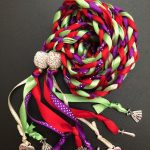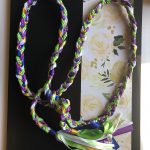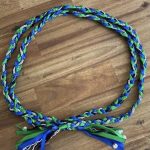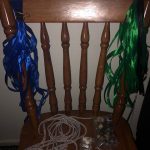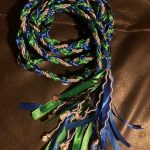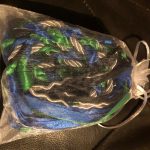What is a Handfasting?
Who does them?
Where did the idea come from?
Why might we consider a Handfasting for our ceremony?
And where on this beautiful earth do we get one from?
My Favourite Ritual
Firstly let me tell you that I am unashamed to admit that this is my very favourite ritual in a Wedding Ceremony. Wedding Handfastings are DA BOMB!
I help my couples create a ceremony that suits them, and ritual is part of that process. What is important, and what is not to each couple, is very different. If a Handfasting is a ritual that suits them I will even personally make an intricate and personalised fasting.
So I am clearly a little biased towards this amazing ritual.
Here are a few that I have made for couples in the past.
So what is a Handfasting?
A Handfasting is a symbolic binding of the hands that inspired the terms “The Bonds of Holy Matrimony” and to “Tie the knot”. Throughout history, in many different ways, and in many different parts of the world, the hands of the betrothed were bound as a sign of their commitment to one another.
So what are its origins, and why is it still so meaningful in today’s modern society?
Celtic Handfasting Traditions
The tradition of a Celtic Handfasting dates back beyond 7000bc, when churches and Priests were scarce, and more for the rich than the everyday folk. Instead, a couple would be Hand-fast over the village anvil by the village elder. The basic idea of the Handfasting was to bind the couple for a year and a day, giving them the opportunity within that time to become legally wed within a church. Once Handfasted a woman would not be bothered by other suitors as it signaled her intention to marry her chosen one.
A simple piece of cord or material would be used, maybe a strip clan tartan… Sometimes more than one piece, from each family, representing their agreement to the union. In many instances, rings were only for the very rich, as metal was too precious a commodity. It was too frivolous to wear it as an adornment when it was needed for tools or weapons
Pagan and Wiccan Traditions
Paganism is a tradition that celebrates the holiness of nature. Worshippers do not follow a formal religion and although committed Pagans gather to worship together, the religion for many is more about an attitude to spirituality and reverence for Mother Earth and the interconnected world all living beings share.
Pagan wedding ceremonies would traditionally not involve an actual legal binding. This goes back to the connection of church and God to marriage ceremonies, therefore a Handfasting was the Pagan equivalent.
Nordic Traditions
The Norsemen, or Vikings, were Pagans, so essentially their ceremonies were much like above.
Weddings were colourful occasions, and brides wore bright dresses, with red being a common colour. Red, blue, yellow and green were popular colours used in Viking times.
It is important to remember that while in modern times a Handfasting alone is not a legal ceremony, in Viking times being Handbound by the High Priestess would have been deemed the equivalent to being married in church.
Vows were centred around practicalities of life, both good and bad, rather than promises of love before God.
Handfasting in Modern Weddings
These days it would not be unusual to combine the legal ceremony and the Handfasting, possibly with a High Priestess and a Civil Celebrant working alongside each other…. But Paganism in its true form is also still followed, and some couples may choose to skip the legally married part altogether focusing on the Pagan ceremony and a celebration.
An Earth Centered, Wicca or Pagan ceremony is fairly easy to organise. Couples can choose their own readings and vows, and work with the Celebrant, Priestess or guide (or a combination) on how to conduct the ceremony. The Celebrant will then conduct the Handfasting ritual, asking the couple to join hands and wrapping the joined hands in a strip of cloth. The couple then exchange vows, asking the sky and earth to bestow their union with their elements.
Couples may choose to include a broom, to sweep away past hurts and a chalice of wine, to represent their combined spirits.
Set up and staging of a Pagan Handfasting will vary, but will usually include some sort of altar with artefacts to invoke the Gods, and representing the four basic elements of earth/water/air/fire.
Do we need a pre-made Handfasting?
A Handfasting doesn’t have to be fancy. Some of my favourites that I have conducted on my couples have been with materials that have had personal meaning to them… Pieces of material from clothing, or ribbons or scarfs with particular meaning to them…
Ask me about the ceremony with 55 separate ribbons from all the guests, that was fun and very unique!!!!
So why do I love performing Handfastings?
I am not a practicing Pagan, or a Wiccan. More, it is that I am a lover of the mystical, anything grounding, and of ritual and symbolism.
I begin a Handfasting ceremony at a place of meaning that is unique to each couple… What does this cord mean to them? And then I go from there, using the wording from Wiccan, Pagan, Celtic and Norse traditions. Often incorporating my couples vows within the knot tying part of their wedding ceremony, to tie in all those important vows and promises that they are making to each other.
This set of photos was a recent photoshoot with Sutton Productions as I wanted to stage and photograph the various important stages of a Handfasting often missed in photos where I am the Celebrant (as it’s not about me, it’s about my couple).
Just amazing, every single time!!!!
These are the Hands
There is a popular poem that is often used in wedding ceremonies with or without the actual Handfasting, sometimes around when vows are being made and rings exchanged. It is called “These are the hands” by an unknown author, but attributed to being a classic Celtic Handfasting reading….
These are the hands of your best friend
That are holding yours on your wedding day
As you promise to love each other
Today, tomorrow and forever.
These are the hands that will work along side you
As together you build your future
These are the hands that will passionately
Love you and cherish you through the years
And with the slightest touch will comfort you like no other
These are the hands that will hold you
When fear or grief wracks your mind.
These are the hands that will give you strength when you need it.
May these hands reach out with love, tenderness and respect.
May these hands continue to build a loving relationship
That lasts a lifetime.
With eyes locked and hands linked,
This is the union of your two hearts,
Two lives and two souls.
Why my Handfastings are unique
Because each one is made to suit the couple. I ask some basic questions, and each couple picks colours..
Usually a colour for each of the parties getting married, and a joint ‘base’ colour of white, black, silver, gold or natural. Maybe colours to represent children or family.
From this information, I begin creation. Each Handfasting consists of around 28 metres of ribbon and cord, and is finished with charms on each end.
These final photos show you some of the stages of creation from cutting the ribbons, through the various plaits, to the final construction. And, although I encourage couples to have it out on show where they will see it regularly, each Handfasting is given to the couple in an organza bag for safekeeping.
You can click here to make a request for me to make you your very own Handfasting, or to enquire about my Handfasting ceremonies.
Handfastings are also available online through SA Boutique Boxes so can be purchased for shipping anywhere in the world.


